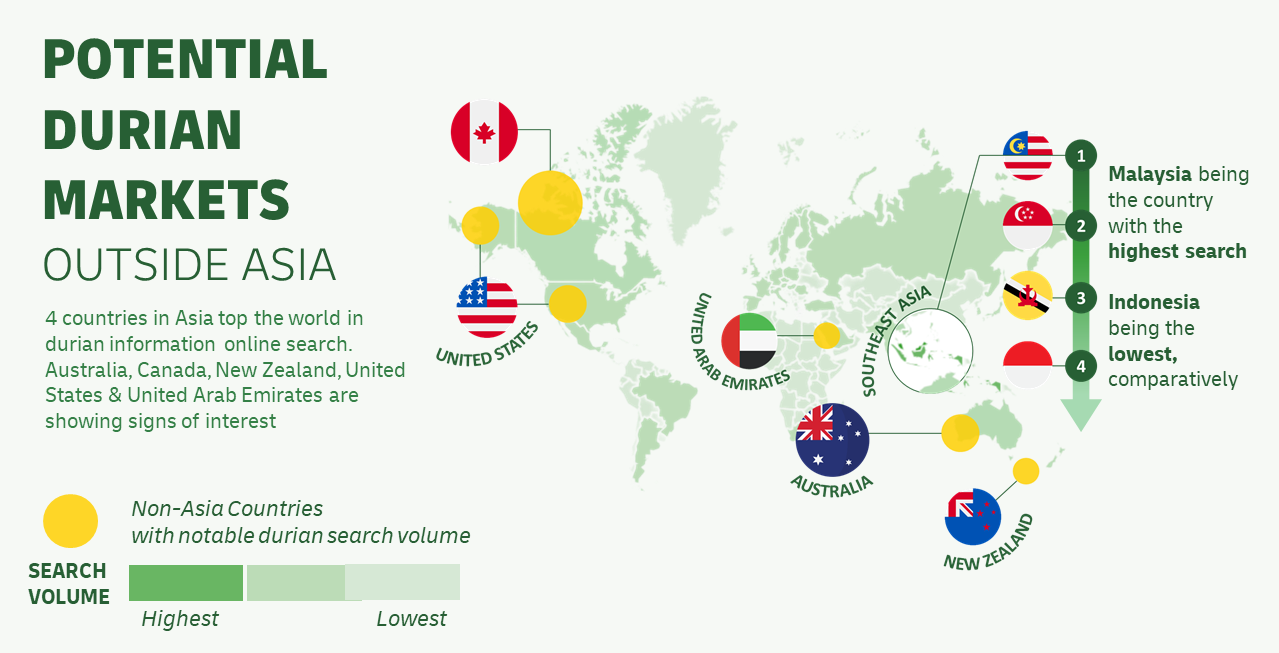Grow your business with the Discover newsletter
Logistics advice & insights straight to your inbox
Subscribe now
Although many are put off by its intense aroma, durian remains one of the most sought-after fruits for its sweet, tasty and creamy flesh. This exotic fruit clearly deserves its "King of Fruits" as its popularity steadily spreads across the globe. From a fruit loved by locals in Southeast Asia, it has become a celebrated food throughout Asia, and now Western countries are joining the club.

According to Grand View Research (GVR), durians have gained popularity in Western countries through cross-cultural cuisine and food blogging. Once a fruit loved by locals in Southeast Asia, it has since gained international renown. Since 2004, within the span of about 20 years, the search volume for the word ‘durian’ has steadily increased in countries like Australia, Canada, New Zealand, the United Arab Emirates and the United States, as shown by data from Google Trends. Durians have also developed a cult following in some parts of the world and havehas been a talking point in the rest.
GVR's 2018 market analysis report estimated the market size of durian at US$17.6 billion. It is also forecast to grow to over US$25 billion, with China continuing to lead in imports and exports. Despite recent setbacks in the industry, such as the COVID-19 pandemic, the above statistics show that durian is a good choice for export companies.
Read on to learn more about the top durian producing countries.
Undoubtedly, Thailand leads the list of durian production by country. Although some variants are not native to Thailand, durian has quickly become one of the nation's most profitable exports.
Perhaps one of the most significant advantages of Thai suppliers is the country's zero import taxes. Conversely, in terms of exports, the Monthong (Golden Pillow) variety is a genuine cash crop for local farmers. Its sweet taste and ability to stay good for a relatively long period of time makes it a preferable purchase for those who wish to savour a durian without it spoiling quickly. Also, it's perfect for more markets such as Hong Kong, which accounts for 90% of Thai durian exports.
There has been a significant reduction in the consumption of durians by locals, but the country has seen an increased demand for the fruit from overseas. Typically, the durian season (eight months) starts from Chanthaburi, Rayong and Trat in the east before heading towards the southern provinces, one of which being Pattani. Ultimately, the Thais can export durian all year round except for the off-season from December to January when large-scale exports become difficult due to the lack of supply.


While Malaysia accounts for just 5% of the global durian export volume, it has steadily expanded its durian industry to be one of the top durian producing countries in the world, with a 107% increase in the country’s durian export value between 2016 and 2020. In September 2020, Malaysia’s durians were imported by 22 countries and regions, bringing the country US$34.7 million. Hong Kong, China, and Singapore are generally the biggest importers of Malaysian durians.
Based on the figures mentioned, Malaysia hardly matches the volume exported by Thailand. However, the country offers the priciest of all durian cultivars – the Musang King. This variety is highly valued among durian lovers, with its popularity only rivalled by that of the Monthong from Thailand. It has one of the highest Brix levels, with an estimated average of between 39 to 44. Brix levels are used to measure the amount of sugar or water soluble content in fruits. Indeed, this export crop is profitable for farmers and exporters.
According to 27Group, almost 70% of Musang King comes from a single state - Pahang. The cultivar's relatively low production volume and limited availability is due to the Southwest Monsoon season. Peak harvest usually lasts from June to August, depending on the weather. Still, experts believe the current export volume of 18 to 25 thousand tonnes of Musang King will reach 40 to 50 thousand tonnes in the next five years.

Even though durian is native to Borneo and Sumatra, Indonesia is one of the less known durian countries. According to Statista, Indonesia’s 2020 export volume to Malaysia reached 94 tonnes, making it one of the world’s leading durian producers. Despite the COVID-19 Pandemic that started in 2020, the export value of fresh durians reached US$232 thousand for the same year.
So far, the local farm and export business has taken an upward trend, thus it is predicted that there will be a rise in durian production and export rates by Indonesia. The biggest obstacle to the growing demand of Indonesian durians is its limited supply, mainly due to the fruit's seasonal nature. Still, many producers have found a solution by planting many variants of the fruit, ensuring consistent production throughout the year.
According to the Survei Sosial ekonomi Nasional survey, Indonesian farmers grow their plantations by an average of 3.7% each year. Moreover, average productivity rises by around 4.8% year on year, effectively lowering the price of the fruit per kilogramme.
Another economic boost is the relatively low consumption of durian per capita (1.18 kilogrammes in 2013), in comparison to higher national production rates (750,000 tonnes in 2014). These estimates show a five-fold difference between production and market prices, making durian exportation a profitable business.
To conclude, it is undeniable that the durian producing countries in Southeast Asia show vast market potential. With increasing demand for raw and durian-based processed products, it has attracted new importers and competitors. However, there still exist many challenges for small and medium-sized companies, some of which include the ongoing COVID-19 pandemic, as well as the spike in fertiliser and fuel prices.
To ensure smooth delivery of your durian exports from Malaysia, DHL Express is happy to offer a viable and efficient solution for small and medium-sized companies. Thanks to the company's Durian Express initiative, business owners can now ship their durians overseas in less than 24 hours.